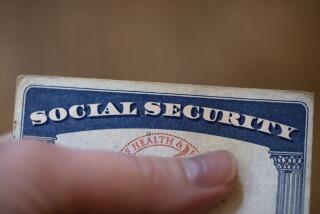Social Security Tax Bite to Get Bigger on Jan. 1 : Beneficiaries’ Checks Will Be Increased 4.2%
- Share via
WASHINGTON — The Social Security payroll tax rate is going up on New Year’s Day for the 13th time in the past quarter-century as workers pay a price for the 1983 bailout of the retirement program.
This latest rate increase will boost the tax to 7.51% from 7.15%. It means employees will pay an extra $36 to Social Security from each $10,000 they earn.
A worker who paid $2,000 in payroll taxes on $27,972 in wages in 1987 will have to pay $2,100 in payroll taxes on the same amount of earnings in 1988--a 5% increase. Employers must pay the same.
In 1988, workers will pay the tax on income up to $45,000; the cutoff in 1987 was $43,800.
“Happy New Year,” Social Security Commissioner Dorcas R. Hardy said jokingly about the impending tax increase in a recent interview.
The bite is even steeper for the self-employed, who were paying a 12.3% rate in 1987 and will pay 13.02% in 1988.
Retirees Are Gainers
The self-employed pay the combined employee-employer tax rate, minus a 2% credit that will disappear after 1989.
While the 126 million workers covered by the program will have to dig a little deeper in 1988, the system’s 38 million beneficiaries will find a 4.2% cost-of-living increase in their monthly checks this week.
Those checks will show up in mailboxes--or be credited directly to beneficiaries’ bank accounts--on Thursday, New Year’s Eve, three days early because of the holiday weekend.
The maximum tax on an employee earning $43,800 in 1987 was $3,130.70. The tax on that same amount in 1988 will be $3,289.38, or $157.68 more. An employee earning $45,000 will pay $3,379.50, or $247.80 more than the maximum this year. That amounts to a 7.9% increase at the top.
The payroll tax was 1% on income up to $3,000 when Social Security started in 1937. It stayed that way until 1950 and has risen every few years since then. This will be the 20th increase in the tax rate.
The tax pays not only for Social Security retirement benefits but survivors and disability coverage as well as most of Medicare.
Built Into Rescue Plan
The wage base--the amount subject to the tax--also has gone up every year since 1971.
After staying at 7.51% through 1989, the rate will climb to 7.65% in 1990. No further increases are planned.
Congress voted in 1977 during an earlier pension crisis to raise the tax to 7.65% in 1990. Originally, no tax increase was scheduled for 1988, but the lawmakers changed that in 1983.
Why 7.51% in 1988 and 1989 instead of simply 7.5%?
That was the figure the National Commission on Social Security Reform plugged into its formulas in 1983, when it was devising a package of benefit cuts and tax increases as part of a bipartisan plan to bail the system out of a recurrent crisis.
That rescue plan worked: Social Security’s trust funds have experienced robust growth. The old-age and disability programs now have $67 billion in reserve, and Hardy says they will grow by $38 billion in 1988.
In a program that pays out well over $200 billion a year in benefits, that is still a cushion of only a few months.
Social Security’s long-range plan is to build up a $12 trillion reserve by 2020--the equivalent then of more than five years’ benefits--and then draw it down to help pay for the baby boomers’ retirement years.
More to Read
Inside the business of entertainment
The Wide Shot brings you news, analysis and insights on everything from streaming wars to production — and what it all means for the future.
You may occasionally receive promotional content from the Los Angeles Times.










